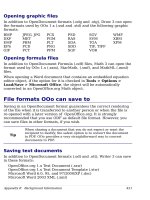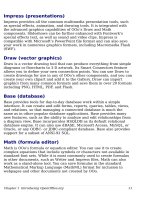Getting Started with Open Office .org 3 part 12 potx
Bạn đang xem bản rút gọn của tài liệu. Xem và tải ngay bản đầy đủ của tài liệu tại đây (4.77 MB, 10 trang )
Creating indexes and bibliographies
Indexes and bibliographies work in a similar way to tables of contents.
Chapter 12 (Creating Tables of Contents, Indexes and Bibliographies)
in the
Writer Guide
describes the process in detail.
In addition to alphabetical indexes, other types of indexes supplied
with Writer include those for illustrations, tables, and objects, and you
can even create a user-defined index. For example, you might want an
index containing only the scientific names of species mentioned in the
text, and a separate index containing only the common names of
species. Before creating some types of indexes, you first need to create
index entries embedded in your Writer document.
Working with graphics
Graphics in Writer are of three basic types:
• Image files, including photos, drawings, scanned images, and
others
• Diagrams created using OOo’s drawing tools
• Charts created using OOo’s Chart facility.
See Chapter 11 (Graphics, the Gallery, and Fontwork).
Printing from Writer
Writer provides a range of choices when printing.
Quick printing
Click the Print File Directly icon to send the entire document to
the default printer defined for your computer.
Note
You can change the action of the Print File Directly icon to
send the document to the printer defined for the document
instead of the default printer for the computer. Go to Tools >
Options > Load/Save > General and select the Load
printer settings with the document option.
Chapter 4 Getting Started with Writer 111
Controlling printing
For more control over printing, use File > Print to display the Print
dialog (Figure 81).
On the Print dialog, you can choose:
• Which printer to use (if more than one are installed on your
system) and the properties of the printer—for example,
orientation (portrait or landscape), which paper tray to use, and
what paper size to print on. The properties available depend on
the selected printer; consult the printer’s documentation for
details.
• What pages to print, how many copies to print, and in what order
to print them. Use dashes to specify page ranges and commas or
semicolons to separate ranges; for example: 1, 5, 11–14, 34–40.
Selection
is the highlighted part of a page or pages.
• What items to print. Click the Options button to display the
Printer Options dialog (Figure 82).
Figure 81. The Print dialog
112 Getting Started with OpenOffice.org 3
Figure 82. Printer Options dialog for Writer
Selecting print options for a document
Selections on the Printer Options dialog apply to this printing of this
document only.
To specify default printing options, you need to use two pages in Tools
> Options: OpenOffice.org – Print (see Chapter 2) and
OpenOffice.org Writer – Print (which looks very similar to the
Printer Options dialog.
Some items of interest on the Printer Options dialog include:
• In the
Contents
section, you might choose not to print graphics or
page background in drafts, for example (to save toner or ink).
• In the
Pages
section, you can choose:
– Print only left (even-numbered) pages or only right (odd-
numbered) pages. These settings are useful when you want to
print on both sides of the page, but do not have a printer that
handles this automatically.
– Print in reversed page order.
–
Brochure
—the results of this selection are discussed in
“Printing a brochure” on page 115.
• In the
Notes
section, you can choose whether to print any notes
that have been added to your document (using Insert > Note),
and where to print the notes.
Chapter 4 Getting Started with Writer 113
Printing in black and white on a color printer
You may wish to print documents in black and white on a color printer,
to save expensive color ink or toner. Common uses are for drafts or
documents to be photocopied in black and white. Several choices are
available.
To print the current document in black and white or grayscale:
1) Click File > Print to open the Print dialog.
2) Click Properties to open the properties dialog for the printer.
The available choices vary from one printer to another, but you
should find an option for Color. See your printer’s help or user
manual for more information.
3) The choices for color may include
black and white
or
grayscale
.
Choose one of these. Grayscale is best if you have any graphics in
the document. Click OK to confirm your choice and return to the
Print dialog, then click OK again to print the document.
To set up OOo to print all color text and graphics as grayscale:
1) Click Tools > Options > OpenOffice.org > Print.
2) Select the Convert colors to grayscale option. Click OK to save
the change.
To set up OOo Writer to print all color text as black, and all graphics as
grayscale:
1) Click Tools > Options > OpenOffice.org Writer > Print.
2) Under
Contents
, select the Print black option. Click OK to save
the change.
Previewing pages before printing
The normal page view in Writer shows you what each page will look
like when printed, but it shows only one page at a time. If you are
designing a document to be printed double-sided, you may want to see
what facing pages look like. OOo provides two ways to do this:
• View Layout (editable view) —see “View layout” on page 84.
• Page Preview (read-only view) —from which you can print
multiple pages onto one sheet of paper.
To use Page Preview:
1) Click File > Page Preview, or click the Page Preview button .
114 Getting Started with OpenOffice.org 3
The Writer window changes to display the current page and the
following page, and shows the Page Preview toolbar in place of
the Formatting toolbar.
Figure 83. Page Preview toolbar
2) Click the Book Preview icon to display left and right pages in
their correct orientation.
3) To print the document from this page view, click the Print page
view icon to open the Print dialog. Choose your options and
click OK to print as usual.
4) To choose margins and other options for the printout, click the
Print options page view icon to display the Print Options
dialog.
Figure 84. Print Options dialog
Printing a brochure
You can print a document with two pages on each side of a sheet of
paper, arranged so that when the printed pages are folded in half, the
pages are in the correct order to form a booklet or brochure.
To print a brochure on a single-sided printer:
1) Plan your document so it will look good when printed half size
(choose appropriate margins, font sizes, and so on). Click File >
Print. In the Print dialog, click Properties and be sure the
printer is set to the same orientation (portrait or landscape) as
specified in the page setup for your document. (Usually the
orientation does not matter, but it does for brochures.)
Chapter 4 Getting Started with Writer 115
2) Click Options. In the Pages section of the Printer Options dialog,
choose Brochure and Right pages. Click OK twice to print the
first side of each page.
3) Flip the pages and put them back into the printer, in the correct
orientation to print on the blank side. You may need to
experiment a bit to find out what the correct arrangement is for
your printer.
4) Click File > Print and check Properties to make sure the printer
setup is still correct.
5) Click Options again. In the Pages section of the Printer Options
dialog, choose Brochure and Left page. Click OK twice to print
the second sides.
6) If your printer can do double-sided, then click on the options for
Left pages, Right pages, and Brochure, and it should not only
do those but collate too.
Printing envelopes
Printing envelopes involves two steps: setup and printing.
To set up an envelope to be printed by itself or with your document:
1) Click Insert > Envelope from the menu bar.
2) In the Envelope dialog, start with the
Envelope
tab (Figure 85).
Verify, add, or edit the information in the Addressee and Sender
boxes (the “from” on the envelope).
You can type information directly into the Addressee and Sender
boxes, or use the right-hand drop-down lists to select the
database or table from which to draw the envelope information, if
desired. See Chapter 11 (Using Mail Merge) in the
Writer Guide
for details on how to print envelopes from a database.
3) On the
Format
page (Figure 86), verify or edit the positioning of
the addressee and the sender information. The preview area on
the lower right shows the effect of your positioning choices.
To format the text of these blocks, click the Edit buttons to the
right. In the drop-down list you have two choices: Character and
Paragraph.
• In Character, you can choose Fonts (Sizes ), Fonts Effects
(Underlining, Color ), Position (Rotating/scaling ),
Hyperlink, Background and more.
• In Paragraph, you can choose Indents & Spacing, Alignment,
Text Flow, Tabs, Drop Caps, Borders and Backgrounds.
116 Getting Started with OpenOffice.org 3
Figure 85. Choosing addressee and sender information
Figure 86. Choosing positioning and size of elements
4) In the lower left of this page, choose the envelope format from the
drop-down list. The width and height of the selected envelope
then show in the boxes below the selected format. If you chose a
pre-existing format, just verify these sizes. If you chose
User
defined
in the Format list, then you can edit the sizes.
5) After formatting, go to the
Printer
page (Figure 87) to choose
printer options such as envelope orientation and shifting. You may
need to experiment a bit to see what works best for your printer.
Chapter 4 Getting Started with Writer 117
You can also choose a different printer or alter printer setup (for
example, specify the tray that holds envelopes) for this print job.
Figure 87. Choosing printer options for an envelope
6) When you have finished formatting and are ready to print, click
either the New Doc or Insert button to finish. New Doc makes
only an envelope or starts a new document with the envelope.
Insert inserts the envelope into an existing document as page 1.
To not proceed with this envelope, click Cancel or press the
Esc
key. You can also click Reset to remove your changes and return
to the original settings when the dialog opened.
7) When the Envelope dialog closes, you are returned to your
document, which now has the envelope in the same file as the
document. Save this file before you do anything else.
To print the envelope:
1) Choose File > Print from the menu bar.
2) On the Print dialog, under
Print range
, choose Pages and type 1
in the box. Click OK to print.
Printing labels
Labels are commonly used for printing address lists (where each label
shows a different address), but they can also be used for making
multiple copies of one label only, for example return-address stickers.
To print labels:
1) Choose File > New > Labels on the menu bar. The Labels dialog
opens.
2) On the
Labels
page, fill in your own label text in the Inscription
box, or use the Database and Table drop-down lists to choose the
118 Getting Started with OpenOffice.org 3
required information, as described in Chapter 11 (Using Mail
Merge) in the
Writer Guide
.
Figure 88. Labels dialog, Labels page
3) Select the label stock in the Brand drop-down list. The types for
that brand then appear in the Type drop-down list. Select the size
and type of labels required. You can also select User in the Type
drop-down list and then make specific selections on the
Format
page.
4) On the
Format
page (Figure 89), choose the pitch, sizes, margins,
columns and rows for user-defined labels, or just verify with a
brand of label stock you have loaded into the printer.
Figure 89. Labels dialog, Format page
Chapter 4 Getting Started with Writer 119
5) Click Save to save your new format.
6) When you have finished formatting, click New Document to
make your sheet of labels or click Cancel (or press the
Esc
key).
You can also click Reset to remove your changes and return to
the original settings when the dialog opened. On the
Options
page, choose to print the entire page of labels or one single label,
then select which one by the column and row. You can also
change printer setup.
7) You can print right away using the Print File Directly icon on
the toolbar or by choosing File > Print from the menu bar, or you
can save the file to print later.
Figure 90. Labels dialog, Options page
Sending a fax using Writer
To send a fax directly from OpenOffice.org, you need a fax modem and
a fax driver that allows applications to communicate with the fax
modem.
Sending a fax through the Print dialog
1) Open the Print dialog by choosing File > Print and select the fax
driver in the Name list.
2) Click OK to open the dialog for your fax driver, where you can
select the fax recipient.
Adding a Fax icon to the toolbar
You can configure OpenOffice.org so that a single click on an icon
automatically sends the current document as a fax. See Chapter 14
(Customizing OpenOffice.org) for instructions.
120 Getting Started with OpenOffice.org 3









